In a multi-part series, Comic Book Film Editor William Gatevackes will be tracing the history of comic book movies from the earliest days of the film serials to today’s big blockbusters and beyond. Along with the history lesson, Bill will be covering some of the most prominent comic book films over the years and why they were so special. This time, we cover the two painful enterprises that were the GHOST RIDER films.
 Let’s not be mistaken, Nicolas Cage is not a comic book fan.
Let’s not be mistaken, Nicolas Cage is not a comic book fan.
Does doing animated features connect with your love of comic books? Look, the truth is I’m not obsessed with comics. I don’t read comics as a 49-year-old man. Not that there’s anything wrong with that but I have other interests that are more in tune with where I’m at right now.–Cage in a December 10, 2013 interview with London’s Metro newspaper.
So, despite tons of empirical evidence to the contrary–such as his taking his stage name from the comic book character Luke Cage to his once owning a comic book collection worth millions to writing a comic book with his eldest son to naming his youngest Superman’s real name (Kal-El) to being attached at various times to star in Constantine, Spider-Man, and Superman Lives, and being cast in Kick-Ass and the films we are talking about today, Nicolas Cage is not a comic fan. This means that the rest of us comic book fans do not have to hold back in saying how absolutely terrible he was in the Ghost Rider films.
 Ghost Rider was created by writer Gary Freidrich, artist Mike Ploog and editor Roy Thomas in the pages of 1972’s Marvel Spotlight #5. Ostensibly an update of the western character of the same name that Marvel published during the 1950s, the concept was also very indicative of the times.
Ghost Rider was created by writer Gary Freidrich, artist Mike Ploog and editor Roy Thomas in the pages of 1972’s Marvel Spotlight #5. Ostensibly an update of the western character of the same name that Marvel published during the 1950s, the concept was also very indicative of the times.
Motorcycle culture was big in the late 1960 and early 1970s. The counter culture movement caused a rise in popularity–and notoriety–to outlaw biker gangs such as the Hell’s Angels. This notoriety translated to the big screen as an exploitation genre as films about biker clubs exploded, including such films such as The Wild Angels, The Born Losers, and Psychomania. Many of these films portrayed the biker clubs as roaming bands of homicidal maniacs and few portrayed them as in league with the devil.
This period was also when stunt motorcycle rider Evel Knievel came into popularity after a failed attempt to jump his motorcycle over the fountains outside of the Las Vegas Caesar’s Palace casino in 1967. He’d do a lot more jumps of the next decade or so, breaking a lot of bones and garnering a lot of imitators, becoming a pop culture icon in the process.
This all happened as a giant change was hitting comics. For almost 20 years, the Comics Code Authority had been keeping a close eye on the world of comic books. They paid particular attention to horror comic books, prohibiting them from using vampires, werewolves, the undead or any sort of reference to the occult. However, by the early 1970s, the Code started relaxing its restrictions on such horror tropes, and Marvel Comics capitalized on this new freedom, publishing titles such as Tomb of Dracula, Werewolf by Night and Son of Satan.
All of these influenced Freidrich, Ploog and Thomas as they created Ghost Rider. He was Johnny Blaze, a skilled motorcyclist who sold his soul to the Devil to save the life of his cancer-stricken foster father, the barnstorming motorcycle daredevil known as Crash Simpson. The devil did cure Simpson’s cancer, only to have him die in a fiery bike wreck just a day later. While Blaze felt cheated, a deal was a deal. The Devil cursed Blaze into becoming a flaming skeleton anytime the sun set. This curse came with a number of beneficial powers, powers Blaze used to fight the Devil’s influence on Earth.
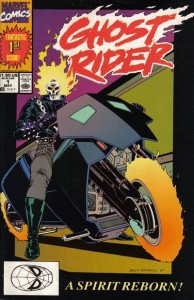 The concept proved popular enough to get its own series in 1973, one which lasted 10 years and 81 issues, outlasting the craze that helped spawn it. The concept was revisited in 1990 with a new series that featured a new character, Danny Ketch, taking over the role. This series lasted 93 issues and introduced new powers to the hero, including a “Penance Stare,” where Ghost Rider would look into a victim’s eyes and force them to relive the pain and suffering they inflicted on others, and a chain that Ghost Rider could control and use to inflict damage on his enemies. Marvel would return to the concept a number of times over the years, and currently has a version being published where Ghost Rider drives a car instead of a bike.
The concept proved popular enough to get its own series in 1973, one which lasted 10 years and 81 issues, outlasting the craze that helped spawn it. The concept was revisited in 1990 with a new series that featured a new character, Danny Ketch, taking over the role. This series lasted 93 issues and introduced new powers to the hero, including a “Penance Stare,” where Ghost Rider would look into a victim’s eyes and force them to relive the pain and suffering they inflicted on others, and a chain that Ghost Rider could control and use to inflict damage on his enemies. Marvel would return to the concept a number of times over the years, and currently has a version being published where Ghost Rider drives a car instead of a bike.
With such an unique origin and striking visual image, it was only a matter of time after the comic book movie genre started gaining steam that Hollywood would take notice of the character. The process started back in 2000, when the rights were bought by Crystal Sky Entertainment. The film soon landed at Dimension Films with David S. Goyer writing and Steven Norrington set to direct. Johnny Depp expressed interest in the role, but he was beat out by Cage, who actively campaigned for the part.
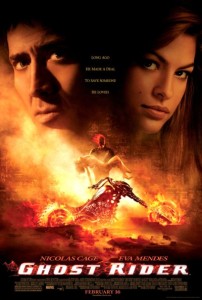 The project went into turnaround at Dimension, but was later bought out by Columbia Pictures. Norrington left due to the delay, and was replaced by Daredevil director Mark Steven Johnson, who rewrote the script. Cage was joined by Eva Mendes as his love interest Roxanne Simpson, Peter Fonda as Mephistopheles, Wes Bentley as Blackheart and Donal Logue as Mack.
The project went into turnaround at Dimension, but was later bought out by Columbia Pictures. Norrington left due to the delay, and was replaced by Daredevil director Mark Steven Johnson, who rewrote the script. Cage was joined by Eva Mendes as his love interest Roxanne Simpson, Peter Fonda as Mephistopheles, Wes Bentley as Blackheart and Donal Logue as Mack.
Production began in February of 2005 and was completed that June. In an ominous sign, the film was set to be released in August 4, 2006, moved to July 14th, then pushed back to February 7, 2007, two years after it started filming.
The film was not without its charms, however, these charms were not enough to overcome the serious problems the film contained.
You have to give credit to a demon biker movie that casts Peter Fonda, star of a number of outlaw biker exploitation films that influenced the character, as the devil himself. Some scenes are beautifully shot and Johnson did a good job melding all the various and sundry incarnations of the character–even the Wild West version–into one film.
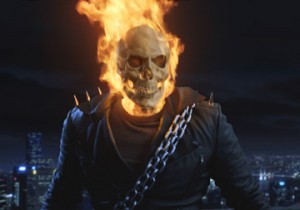 But the overall film is sloppy. Blame has to start with Cage. The actor manages to reign in his hammy over acting, saving it for the scenes when he transforms into the Ghost Rider, but what we get instead isn’t much better. What we get is a low-key Elvis impersonation (if Wild At Heart was Cagelvis cranked up to 10, we get a Cagelvis at 3 or 4 here), fleshed out with character tics such as eating red and yellow jelly beans out of martini glasses, a child-like obsession with monkey documentaries, and an inexplicable love for the music of the Carpenters. You know, stuff we all have in common. But it doesn’t belie the fact that Cage is too old for the role. The film tries to paint Johnny Blaze and Roxanne Simpson as childhood sweethearts of approximately the same age, and then cast Eva Mendes, who is 10 years younger than Cage, as the present-day Roxanne. Cage looks foolish trying to act a decade younger than he actually is.
But the overall film is sloppy. Blame has to start with Cage. The actor manages to reign in his hammy over acting, saving it for the scenes when he transforms into the Ghost Rider, but what we get instead isn’t much better. What we get is a low-key Elvis impersonation (if Wild At Heart was Cagelvis cranked up to 10, we get a Cagelvis at 3 or 4 here), fleshed out with character tics such as eating red and yellow jelly beans out of martini glasses, a child-like obsession with monkey documentaries, and an inexplicable love for the music of the Carpenters. You know, stuff we all have in common. But it doesn’t belie the fact that Cage is too old for the role. The film tries to paint Johnny Blaze and Roxanne Simpson as childhood sweethearts of approximately the same age, and then cast Eva Mendes, who is 10 years younger than Cage, as the present-day Roxanne. Cage looks foolish trying to act a decade younger than he actually is.
Of course, the reason why Cage has to resort to character tricks is because there is no characterization in the script. No time is developed to build up the characters. Why are Johnny and Roxanne sweethearts? Because the script tells us they are. We are supposed to be sad when Johnny’s dad dies, but there is little in the way of defining the father/son relationship before the death scene. Blackheart’s minions are a set of interesting powers but have no discernible personality between them. And for all their fancy powers (based on the elements of Air, Earth and Water) they provide absolutely no threat to Ghost Rider whatsoever.
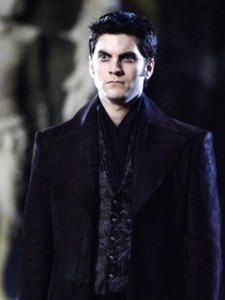 This, of course, leaves the actors with little to work with. Mendes does well with what she is given but she isn’t given much. Fonda tackles his role with the zeal of a man picking up his prescriptions at the local CVS. Wes Bentley gets singled out in most reviews as the worst actor of the cast, and he is miscast, but it’s not fair to single him out because his character is underwritten. The film never sells Blackheart as a serious threat and Bentley simply is not equipped to make up the difference. The only member of the cast that comes out looking good is Donal Logue, who manages to inject a fair amount of life into the stock “best friend of the hero” archetype he was cast in.
This, of course, leaves the actors with little to work with. Mendes does well with what she is given but she isn’t given much. Fonda tackles his role with the zeal of a man picking up his prescriptions at the local CVS. Wes Bentley gets singled out in most reviews as the worst actor of the cast, and he is miscast, but it’s not fair to single him out because his character is underwritten. The film never sells Blackheart as a serious threat and Bentley simply is not equipped to make up the difference. The only member of the cast that comes out looking good is Donal Logue, who manages to inject a fair amount of life into the stock “best friend of the hero” archetype he was cast in.
The film is full of holes and inconsistencies, both in plot and in production. It is stated in the film that Blaze can turn into Ghost Rider at night or when confronted with great evil. Then it becomes at night AND when confronted by great evil. Then it becomes whenever there’s a little shade around, he can turn. It is noted that the bad guys cannot step foot in a graveyard because it is “consecrated ground” but have no problem traipsing through churches with impunity. Ghost Rider’s power is so immense that if he travels full speed down a city street that the macadam will melt, cars will flip over in the air, and parking meters will turn into puddles of goo. Well, unless he is chased by the cops, because none of that happens in a chase scene later in the film.
It is also fun to see the same extras in the crowds of two separate Johnny Blaze stunt performances in two separate cities or a scar that to about ten minutes of screen time to get stitched up disappear in the very next scene that takes place only a few hours later. Where’s a continuity editor when you need them?
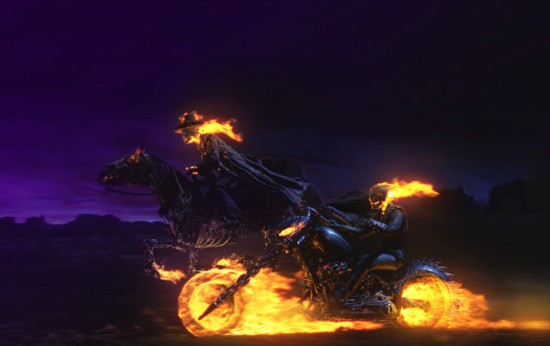 This bouillabaisse of awfulness culminates in the climax, where Blaze meets up with the Ghost Rider from the old west who in turn leads him to the final battle to the sounds of a rock version of “Ghost Riders in the Sky.” It’s a pretty badass scene and relatively smart too. Blackheart has been kicking Johnny’s but the whole movie, why not even the odds a little bit by throwing two Ghost Riders at him?
This bouillabaisse of awfulness culminates in the climax, where Blaze meets up with the Ghost Rider from the old west who in turn leads him to the final battle to the sounds of a rock version of “Ghost Riders in the Sky.” It’s a pretty badass scene and relatively smart too. Blackheart has been kicking Johnny’s but the whole movie, why not even the odds a little bit by throwing two Ghost Riders at him?
Only, we don’t get two Ghost Riders. After they reach their destination, the old Ghost Rider powers down and rides away. Seeing it in the theater, I thought that the filmmakers were doing the special effects ran out of money for the climax, a thought that was reaffirmed when Nicolas Cage went after Blackheart for most of the climactic battle not as Ghost Rider but as Johnny Blaze, armed with only a shotgun no less.
I can go on. I can spend paragraphs talking about how bad the dialogue was (“Any man that’s got the guts to sell his soul for love has got the power to change the world. You didn’t do it for greed, you did it for the right reason. Maybe that puts God on your side. To them that makes you dangerous, makes you unpredictable. That’s the best thing you can be right now.”) or how Johnny’s decision to keep the curse at the end of the film makes no sense other than to keep the possibilities of sequels open.
However, the film made money. Although it barely made $5 million more than its $110 million budget in the US, it made another $112 million overseas, making it enough of a hit that it garnered a sequel five years later.
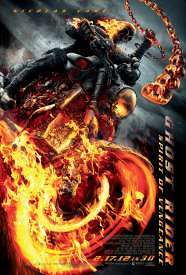 Much like Punisher: War Zone, this was more of a soft reboot than a pure sequel. Johnny Blaze was more active in choosing to sign his soul away (in the first film, Mephistopheles tricks him into signing by giving him a paper cut and letting a drop of blood land on the signature spot. Really) and being more proactive in wanting to get rid of the curse.
Much like Punisher: War Zone, this was more of a soft reboot than a pure sequel. Johnny Blaze was more active in choosing to sign his soul away (in the first film, Mephistopheles tricks him into signing by giving him a paper cut and letting a drop of blood land on the signature spot. Really) and being more proactive in wanting to get rid of the curse.
The action takes place in Eastern Europe (most likely because it was cheaper to shoot there, the sequel cost only $57 million to make, just a little more than half the budget of the original), as Johnny Blaze is called on to protect a young boy who is intended to become a vessel for the devil (This time played by Ciaran Hinds). However, Blaze must struggle with the Ghost Rider, who has become a true spirit of vengeance, attacking any human who had just a little bit of sin in them.
 I reviewed the film here. At the time, I thought the sequel was better than the original, but, having re-watched the original, I’m not so sure. The sequel is plagued with the same clunky script problems the original suffered from, including plot holes big enough to jump a motorcycle through. There is still hammy over acting, which is good when Hinds or Idris Elba is doing it, not so much when it’s Cage or Johnny Whitworth. And, once again, Ghost Rider’s powers fluctuate whenever the script needs them to.
I reviewed the film here. At the time, I thought the sequel was better than the original, but, having re-watched the original, I’m not so sure. The sequel is plagued with the same clunky script problems the original suffered from, including plot holes big enough to jump a motorcycle through. There is still hammy over acting, which is good when Hinds or Idris Elba is doing it, not so much when it’s Cage or Johnny Whitworth. And, once again, Ghost Rider’s powers fluctuate whenever the script needs them to.
The film made only a paltry $132 million worldwide, but considering the film cost so little to make, it still came back with a sizable profit. There was brief talk of another sequel, one without Nicolas Cage, but the rights holders saw the diminishing returns and allowed the right to revert back to Marvel. Marvel has no plans for a Ghost Rider film in the near future.
Which is a shame. I think there is still untapped potential in the concept. I think a Grindhouse take on the subject would work, and Nicolas Cage aging out of the role is a good thing. Maybe if we get a little bit farther from these film, Marvel will give it another shot.
Next time up, we will get to the film series that turned the world of comic book films on its ear: the Marvel Cinematic Universe.




